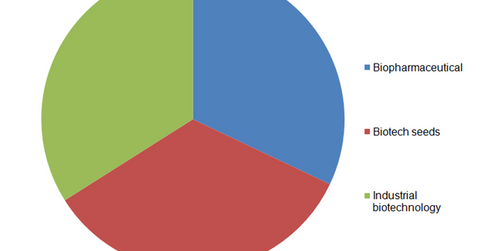A Must-Read Overview of the US Biotechnology Industry
Biotechnology is simply ‘technology based on biology.’ The biotechnology industry includes food technology, genetic research, healthcare, and environmental technology.
July 2 2015, Published 11:14 a.m. ET

The biotechnology industry
According to the Biology Technology Organization, biotechnology is simply “technology based on biology – biotechnology harnesses cellular and biomolecular processes to develop technologies and products.” These technologies and products include food technology, genetic research, healthcare, and environmental technology.
The above graph shows the breakdown of total revenues that biotechnology companies (IBB) earn in the various disciplines. Biopharmaceuticals are drugs developed from biological sources and used to treat animal and human diseases. They account for about a third of total revenues, or $150 billion, earned by the biotechnology sector in 2014.
Biotech seeds, or genetically modified food, is the cross discipline between biotechnology and agriculture. Industrial biotechnology includes all other applications of biotechnology in sectors like chemicals, biofuels, feedstock, and energy.
Biopharmaceuticals
Biopharmaceutical companies such as Amgen (AMGN), Biogen (BIIB), Regeneron Pharmaceuticals (REGN), and Celgene (CELG) differ from pharmaceutical companies based on a drug’s development process. Traditionally, pharmaceutical companies have manufactured small molecule compounds that contain various chemicals. The drugs are termed “small molecule” since the molecule is small enough for the body to absorb its constituents in pill form.
Biopharmaceutical drug manufacturing involves programming live cells to produce large molecule drugs on a mass scale. The manufacturing process of biopharmaceutical drugs is more complex and capital-intensive than small molecule drugs. So these companies take longer than pharmaceutical companies to generate positive cash flows. Biopharmaceutical drugs have historically had higher commercial success rates than traditional pharmaceutical drugs.
